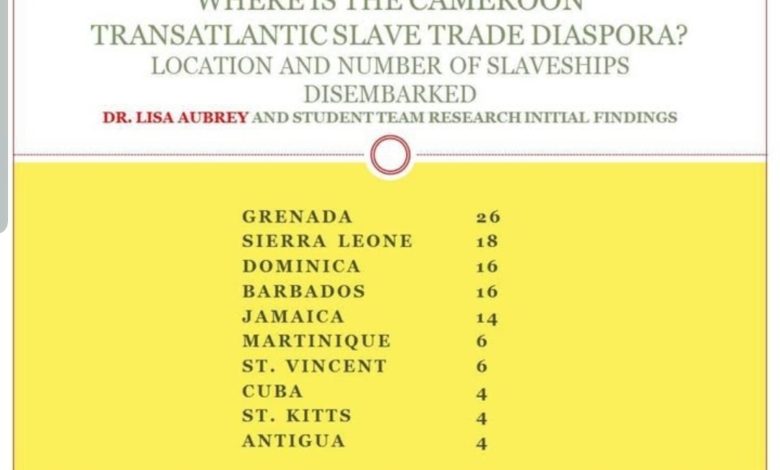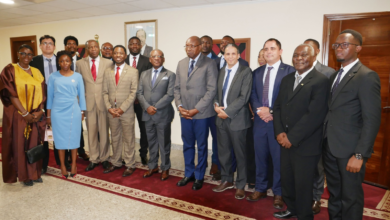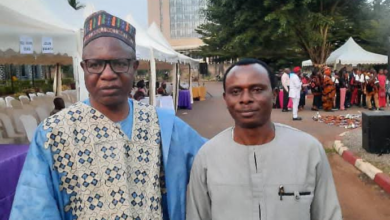Cameroon Was Bigger Slave Exit Point Than Ghana, Senegal – Dr. Lisa Aubrey

By Hans Ngala
An African-American historian Dr. Lisa Aubrey has revealed that Bimbia in today’s SW Region of Cameroon was a far bigger slave exit point than Goree in Senegal or in Cape Coast and Elmina in Ghana.
According to Dr. Aubrey’s research which began in 2010 and was recently updated – more than 100 ships exited from Bimbia with slaves captured from the Grassfields mainly.
“Where were the Tikar, Bamileke, Fulani, Hausa, Masa, Ewondo, Kotoko, Bassa and other enslaved forcibly shipped and sold? Many did not survive the middle passage. They were killed or died of maltreatment. BIMBIA was one exit port European slave traders cultivated and used for pillage and profit” Aubrey says.
The historian’s remarks came ahead of the INTERNATIONAL DAY FOR THE REMEMBRANCE OF THE SLAVE TRADE AND ITS ABOLITION on August 22. The event was commemorated in Limbe, SWR a few kilometers from the historic site in Bimbia.
Aubrey who is American has been to Cameroon and has written extensively on the Bimbia slave port, appearing on national TV and also has two books on Bimbia “In Search of Bimbia” and “Bimbia Devoilee”.
Her research reveals that a total of 114 ships left Bimbia, Cameroon with slaves to places such as Grenada, Argentina, Dominica, Jamaica, Martinique, St. Vincent, Cuba, St. Kitts and Antigua
The revelation by Dr. Lisa Aubrey that Bimbia, in Cameroon’s Southwest Region, was a far larger exit point for enslaved Africans than the widely known Goree Island in Senegal or Elmina in Ghana, is not only historically significant but socially transformative for contemporary Cameroon and its diaspora.
For too long, the narrative of the transatlantic slave trade has been dominated by Ghanaian and Senegalese coastal ports such as Elmina and Goree. These sites have become symbolic pilgrimage grounds for African Americans and other descendants of enslaved Africans seeking to reconnect with their ancestral past. The fact that Bimbia was, in fact, a bigger exit point—where over 114 ships carried enslaved Cameroonians to the Americas—reshapes how both Cameroonians and the diaspora understand their history.
For contemporary Cameroonian society, this truth has implications for national identity. Recognizing Bimbia as central to the slave trade highlights the role that Cameroon’s diverse ethnic groups—Tikar, Bamileke, Bassa, Fulani, Ewondo, and others—played in this painful history. It shifts the narrative from one of silence to acknowledgment, compelling Cameroon to integrate the story of Bimbia into its education system, cultural heritage, and tourism development. Just as Ghana has built global recognition with its “Year of Return,” Cameroon could harness Bimbia’s history to foster both remembrance and reconciliation while boosting cultural tourism.
For the Cameroonian diaspora in the Americas, this discovery is deeply personal. Many African Americans, Afro-Caribbeans, and Afro-Latin Americans are unaware that their ancestors may have been shipped from Cameroon. By reclaiming Bimbia’s centrality, they gain a stronger connection to their roots and a clearer sense of belonging. Knowing that enslaved Cameroonians were taken to Grenada, Jamaica, Cuba, Argentina, and the United States underscores the widespread dispersal of Cameroon’s sons and daughters across the globe. This knowledge creates opportunities for reconnection between Cameroonians at home and their scattered kin abroad.
Furthermore, Bimbia being historically larger than Elmina or Goree matters because it challenges the selective memory of slavery. It calls for Cameroon to assert its rightful place in global narratives of the slave trade and to ensure that its people are no longer invisible in world history. Honoring Bimbia restores dignity to the countless men, women, and children who perished in the Middle Passage or endured slavery in the Americas.
Ultimately, embracing Bimbia’s history is not just about looking back. It is about fostering healing, strengthening diasporic bonds, and positioning Cameroon as a key voice in the global conversation on slavery, memory, and reparative justice.




